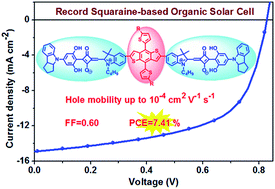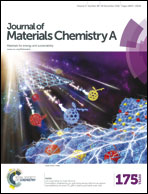An effective π-extended squaraine for solution-processed organic solar cells with high efficiency†
Abstract
Among the multifarious kinds of small molecular photovoltaic materials, squaraines are quite attractive due to their facile and low-cost synthesis, intense and broad absorption in Vis-NIR spectral regions with very high molar extinction coefficients. Nevertheless, one key factor limiting the performance of squaraine-based organic solar cells (OSCs) is their low fill factor (FF), which is ascribed to the low hole mobility of the active layer. Here, we successfully reported a large π-extended bis(squaraine) electron donor, namely D-BDT-SQ, that showed one order of magnitude enhanced hole mobility in the donor–acceptor composite film, up to 10−4 cm2 V−1 s−1. As a result, an impressive power conversion efficiency (PCE) of 7.41% with a high FF of 0.60 was achieved for solution-processed bulk heterojunction OSCs when the working temperature of devices was 80 °C, which is, to the best of our knowledge, the record PCE among those reported for squaraine-based single-junction OSCs.



 Please wait while we load your content...
Please wait while we load your content...